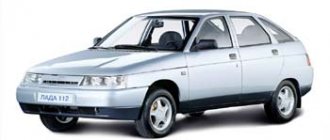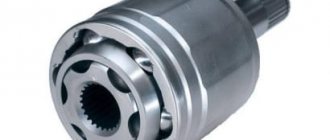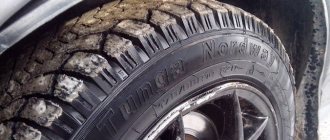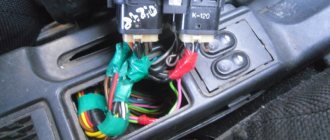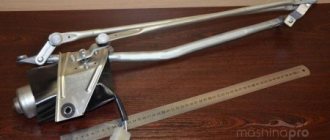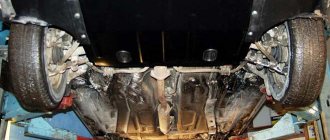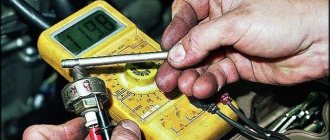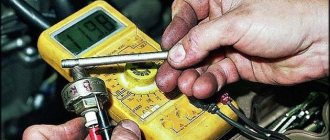Domestic cars are always popular among car owners. The main reason is availability in terms of price, as well as inexpensive maintenance. Back in Soviet times, VAZ earned a reputation as a high-quality and reliable car.
True, over time, drivers began to trust VAZ cars less, but this does not apply to older models like 2112 and those that came before it. The VAZ-2112 car began to be produced in the late 90s. And he still enjoys trust.
History of creation
The VAZ 2112 hatchback model was produced since 1999, becoming the successor to the 2110 sedan and 2111 station wagon. The “Twelfth” became a close analogue of the famous tenth model, but had a slightly shortened body. As planned by the manufacturers, the 2112 was supposed to combine all the advantages of the “ten” and “eleven”, so the five-door hatchback was chosen as the body type.
VAZ-2112 Pre-production (1994)
The 12th model began to be mass produced in 2000; it lasted 8 years on the assembly line. Unlike the sedan and station wagon of the tenth series, the assembly of the “dvenashka” was not transferred to the Ukrainian ones.
Although the twelfth model was positioned as an improved “ten”, the improvements here are very conditional and not always obvious. Therefore, the difference between these two models is not too big. AvtoVAZ designers continued to look for new solutions, as a result of which other lines and modifications appeared, which also have both their pros and cons.
Short description
The VAZ-2112 engine was installed on VAZ-2110, VAZ-2111 and VAZ-2112 cars. The engine was not created from scratch, the base was the 21083 engine. The engine retained the basic geometric dimensions of the 83rd engine, but at the same time it was radically different from it, both in terms of power and performance indicators. These and General Motors were involved in the development of the engine. In particular, together with General Motors, a distributed fuel injection system was developed. The engine turned out to be very economical. The main disadvantages of the engine are the lack of torque at low speeds (noticeable pick-up at 3500 rpm), unreliable belt drive and rollers, bending valves when the timing belt breaks
Exterior
Looking at the “twelve”, it immediately becomes clear that its prototype was the “ten”. Externally, these two cars are very similar, it is immediately clear that they belong to the same family: the same rounded, smooth lines and roundness of the body, the same heaviness, especially in the rear of the car. Of course, whether you like the design of the car is a matter of taste. Many note that the twelfth model is the most beautiful of the entire line.
Lada 2112 (1999–2008)
It is also noticeable that the designers tried to give the car some sportiness by adding a rather large spoiler to the trunk door, rounding the body as much as possible and replacing the thirteen-inch “tens” wheels with 14 inches. However, despite all the developers’ tricks, it’s quite difficult to call the 12th Lada sports. Changes also affected the roof of the car. Here it is more sloping, making the car look more interesting. The body length of the 2112 model is slightly shorter than that of the “ten”.
If we compare the car with the 11th model, then the rear door is noticeably larger, which can be opened both from the outside using the key and from inside the cabin by pressing the corresponding button. But the fifth door opens only if you pull it on the plastic spoiler, which does not have a positive effect on it.
Lada 2112 (1999–2008)
The trunk, like the hood, boasts gas struts. It is convenient to load, the volume is 400 liters. The shelf in the trunk rattles and knocks a lot when driving. You can get into the car through the trunk door if all other doors are blocked or jammed.
Tens body care and repairs
The overall body of the “ten” looks more reliable, durable and resistant to corrosion. All-metal and partially galvanized, it comes off the assembly line already treated with anticorrosive, ready for harsh operating conditions.
On the other hand, we must pay tribute to our car owners, who are accustomed to finishing everything with their own hands. In particular, while remaining adherents of the domestic automobile industry, they turn a blind eye to the differences and shortcomings of technology in comparative terms and take additional care of the body so that it serves for many years without problems. Russian car owners almost always add special protection to the standard anti-corrosion treatment.
Preventative work specifically involves tinting the bottom of the car, treating sills and fender liners with Movil.
Note. We can say with confidence that among the “dozens” with high mileage, even today you can find examples that have been so well cared for by the owner that they look like new.
People's love for the “ten” is also symbolized by the succinct names given to the car by amateurs. “Matryoshka”, “pregnant antelope”, “chubby” - all these nicknames, albeit with some degree of irony, speak of love for the car. If at first the unique, new design of the VAZ model raised questions, then over time the angular shapes of the “bow” and “stern” became familiar.
Here are the preventive works that are usually carried out on the body of the “tens” throughout the entire operational period:
- Caring for paintwork;
- Lubrication of metal components of the body;
- Cleaning of technical holes;
- Periodic anti-corrosion protection of the body as a whole and treatment of hidden areas;
- Noise insulation;
- Sealing.
To protect the original paintwork of the body, you must be able to select the appropriate polishes and follow the rules for their application. In addition, the VAZ 2110 must first be washed when the car is new, only with cold water, and for treating paintwork, use polishes that do not contain abrasives.
Caring for the paintwork of a car with a 3-5 year mileage implies a different scenario:
- Use products for weathered surfaces (they contain a certain amount of abrasive).
Accordingly, for a body older than 5 years:
- Use products specifically designed for aged surfaces.
It is also recommended to polish the body in small areas by hand using clean flannel. This is done to prevent the polish from drying out during application.
Polishes PMA-1 and PMA-2 have proven themselves well.
More good tips on the body in general:
- Do not store the car under rubber covers;
- Do not place rubber objects on painted surfaces (they will leave stains that are almost impossible to remove);
- Protect the paintwork from contact with alkalis, brake fluid and other chemicals that can destroy the coating.
It is recommended to lubricate rubbing parts and body elements from time to time in order to increase the durability of the metal frame. So, this should be done at least every 15 thousand km of the car or once a year.
Interior
The interior of the car is simple and not very presentable. You won’t find any “bourgeois excesses” here. The only exception is electric windows and heated front seats, but this is not found in all modifications of the car.
The steering wheel is large and very antediluvian. The steering column is height adjustable only. Moreover, some models come without power steering and electric power steering, which is a significant disadvantage.
Torpedo Lada 2112 (2006-08)
To the right of the steering wheel is a console with a heater, radio, on-board computer (if equipped) and main keys. The heater, in theory, should be adjustable in order to separately heat the windows, top and bottom of the cabin, but in reality everything is heated at once. There are no airbags in the cabin.
The glove compartment is quite large and even has a backlight. The position of the exterior mirrors is adjusted by a special lever, but it is adjusted very mediocrely, so usually no one uses it.
A tall person is unlikely to be comfortable in the back row of seats, because his head will touch the ceiling. Long-legged people will also not be very comfortable, since there is quite a bit of space left to the front seats. The width of the cabin is cramped; only two passengers can be comfortably accommodated. Three people will fit, but they will be cramped.
Interior of Lada 2112 (1999–2008)
The rear windows are manual and constantly stick. As anyone who has ever owned a Lada, Zhiguli or any other AvtoVAZ product knows, the windows go down exactly to the level they want. Often it is completely impossible to lower the glass completely; it gets stuck in the middle and does not move anymore.
The rear row seats recline together or separately, which increases the size of the trunk, so you can put a fairly large load in the car.
Tuning
Now we come to the most interesting part. After all, almost every modern driver wants to tune the VAZ 2112 engine. This allows not only to increase power, but also efficiency.
- The first thing you can do is chip tuning the unit. In essence, this is a simple firmware of the brain, which is very interesting. Almost every driver can do it.
- You can also replace the camshaft and bore the valves. This tuning of the VAZ 2112 engine is very common not only in Russia, but also abroad.
- If you want to increase the turbo of the VAZ 2112, then you should install a special compressor. It has only one drawback: the power unit heats up very much. Because of this, it is necessary to install a high-quality cooling system. Tuning also allows you to get rid of the car’s tripping.
- Experts recommend installing only one compressor. After all, if you install a little more, more power will be supplied, and accordingly the unit will heat up even more.
- If you want more power, you can install a throttle. This method allows you to improve the response of the gas pedal and normalize the operation of the power unit. You don't have to attach all sorts of turbo systems, which is very good. This method is based on installing a throttle in each cylinder. Agree, a very good idea for a domestic car.
- It is worth noting that almost all drivers want to increase the turbo of their iron horse. To do this, install a special supercharger that increases power.
Engine modifications
Under the hood of Lada 2112 (1999–2008)
In total, there are 6 engine modifications for the VAZ 2112:
- 21120 – the basic version of the 1.5 liter internal combustion engine. The disadvantage is the presence of free space inside the cylinder head and the block itself.
- 21124 – increased power (up to 89 hp) and increased engine capacity (up to 1.6 liters).
- 21126 – power increased to 98 hp. with an engine capacity of 1.6 liters.
- 21127 – the volume is still 1.6 liters, but the power is increased to 106 hp.
- 21128 – power is 105 horses, which is achieved by increasing the volume of the combustion chamber (1.8 liters). The problem with the valves bending has been resolved.
- 21129 – the engine has a volume of 1.8 liters, a phase shifter has been added.
Body parts most susceptible to deformation
Replacing the timing belt VAZ 2112 16 valves
Sharp braking or untimely start provoke, first of all, damage to the bumper. If it is insignificant, then during repairs it is possible to achieve the performance of standard geometry. In the presence of complex deformations, this cannot be done, so it is easier to replace the damaged body part with a new one.
If the owner of the car does not take enough care of the condition of the body, then those parts that have close contact with the road surface are quickly eaten away by corrosion. And repairing the hood, doors and hidden body parts instead of timely prevention is already more difficult and expensive.
Options
Lada 112 Coupe (2002–06)
The car was produced in several versions:
- 21120 – basic version with a 16-valve 1.5-liter engine with multipoint injection. Equipped with 14-inch wheels. Engine power – 93 hp.
- 2112i – version with fuel injection system.
- 21120 GLI (Gran Luxury Injector) – luxury version of the car.
- 21121 – modification with an engine capacity of 1.6 liters. Power – 81 hp
- 21122 – simplified, budget option. It was produced without electric windows, with 13-inch wheels and brakes from the VAZ 2108.
- 21123 Coupe - a three-door version, the so-called “coupe”, although in fact it is an ordinary three-door hatchback. It was assembled individually and in limited edition. The coupe's body is more rigid, as is the suspension. Handling is better than the standard version. The car was expensive, produced in 2002-2006.
- 21124 – injection version with a 1.6-liter engine. By increasing the depth of the groove in the piston crown, the creators managed to solve the problem of valve bending, which plagues the standard version.
- 21128 – modification with a 1.8-liter engine. Power – 105 hp.
- 2112-37 – racing version with a 1.5 liter engine, equipped with a roll cage.
- 2112-90 “Tarzan” – version with all-wheel drive. A Niva engine (1.7 and 1.8 liters) was installed.
Features of the piston group
The updated engine also received new pistons, in the bottom of which there are valve wells: four recesses 5.53 mm deep are made in each piston, which are designed to prevent bending (breakage) of the valves in the event of a timing belt break.
Previously, if this happened, the connection between the valves and the crankshaft was lost, their movement stopped, but the shaft itself, carried by the flywheel, continued to rotate by inertia, and accordingly, the pistons moved. As a result, they collided with the valves. The result is that they bend, break, or even pierce the bottom of the piston.
The dimensions of the piston rings, which can be either cast iron or steel, remain the same: 82 mm.
The piston pin has a floating fit, and its axial fixation is ensured by retaining rings. The length of the finger is 60.5 mm, and its diameter is 22 mm.
The 21124 engine connecting rods are interchangeable with the 2112 connecting rods.
Specifications
Visibility
Visibility in the cabin is good, everything is perfectly visible from the driver's seat, the glass area is large. However, the rear view is partially blocked by the spoiler.
Body
The bodies of all Lada cars leave much to be desired. They are made of thin and very low quality metal that rusts instantly. The sills, arches and lower parts of doors are most susceptible to corrosion. If you find a VAZ 2112 in good condition, then both the arches and the sills will probably be overcooked.
Mileage
If you monitor the car and the condition of the engine, then the VAZ 2112 can “run” up to 200-250 thousand, which is not too much. On the other hand, the engine can be rebuilt or a new one installed, because Lada engines are obscenely cheap.
Lada 2112 (1999–2008)
The fuel consumption of the “twelfth” cannot but rejoice. So in urban conditions it consumes 7-9 liters per 100 km. On the highway - 5-6 liters.
Transmission
The 12th model was equipped with a 5-speed manual transmission. It differs from the gearbox on the VAZ 2110 only in name.
Disadvantages of a gearbox on a “two-wheeler”:
- unreliability;
- unclear switching;
- strong howl;
- frequent wear of the synchronizer, accompanied by crackling and noise when changing gears;
- oil leaks through seals, breather and gaskets;
- knockout of the gear or refusal to engage due to wear of the bushings;
- failure of bearings and gears after 100 thousand mileage.
Suspension
The front suspension of the VAZ 2112 is independent, the rear suspension is dependent. The problem with all LADA cars is CV joints and bearings that quickly fail. The struts also quickly begin to leak, the springs rust. The quality of spare parts generally leaves much to be desired, including new ones. Owners complain that some elements have to be replaced several times, because new parts arrive already defective or break in the first months of operation.
Development of the model range
AvtoVAZ designers began to think about developing a sedan based on the VAZ 2108, 2109 series in the mid-80s. It was the development of this that led to the design split in Tolyatti, the consequences of which are still felt today. Instead of simply changing the contours of the rear part of the VAZ 2109 body and making a spacious trunk, the designers proposed almost a thousand different changes, including quite expensive ones. An electronic engine control and diagnostic system (on-board computer), a new galvanizing technology, power steering, etc. were provided. AvtoVAZ management, instead of closing the expensive project, decided to carry out work in two directions:
- complicated development of VAZ 2110;
- creation of a simplified version of the VAZ 21099.
Subsequently, both concepts coexisted in the design bureau and on the factory assembly line. The VAZ 2110 line developed into the 110 family and later into the Lada Priora, and the VAZ 21099 line became the basis of the Samara 2, Kalina and Kalina 2 family.
This development of the line has led to the fact that the plant’s assembly line currently produces series of cars with very similar technical characteristics, with weakly expressed sectoral market preferences.
Generations 2112
1995
2112
2000
21120
2000
21122
2004
21121
2004
21124
Brake system
Front brakes are disc, rear brakes are drum. Although the brakes on the “two-wheeler” are quite mediocre and ineffective, owners most often do not complain about them, because repairs cost a small amount. The brake pedal is usually a little stiff, but the braking distance is acceptable.
Lada 2112 (1999–2008)
We will enter the remaining technical characteristics into the table.
| Parameter | Index |
| Body shape | hatchback (5 doors), coupe (3 doors) |
| Engine volume, l | 1.5, 1.6, 1.8 |
| Length, mm | 4170 |
| Width, mm | 1680 |
| Height, mm | 1420 |
| Wheelbase, mm | 2492 |
| Ground clearance, mm | 160 |
| type of drive | front |
| Gearbox type | 5-speed manual |
| Weight, kg | 1495 |
| Trunk volume, l | 400 |
| Fuel tank volume, l | 43 |
| Fuel type | petrol |
Factory dimensions
But the main dimensions are:
Length:
- if we take the end points of the front and rear bumpers, then here we have 4265 mm;
- length between the centers of the front and rear wheels, the so-called. wheelbase is 2492 mm;
- from the center of the front wheel to the extreme point of the front bumper - 829 mm;
- from the center of the rear wheel to the end point of the rear bumper - 944 mm.
The height of VAZ 2110 is 1420 mm.
Factory dimensions for length and width
Width:
- in front at the extreme points of the “factory” mirrors – 1875;
- front excluding mirrors (purely hardware) – 1680 mm;
- distance between the centers of the front wheels – 1400 mm;
- the rear of the car has a width between wheel centers of 1370 mm.
Controllability
It would seem that the reduced base (when compared with the “ten”) should have made the car more obedient, but for some reason everything is different with the “two”. Handling here is very mediocre. When turning, you often have to fight with the steering wheel, which constantly strives to return to its original position. There are cars without power steering, the driving of which gives little pleasure, and the steering wheel seems to be filled with lead and generally refuses to rotate adequately.
Lada 2112 (1999–2008)
When cornering, the body often begins to sway and roll to the side, causing the wheels to lose traction on the asphalt. This happens especially often on rough roads. It is better not to accelerate too much in the VAZ 2112, because at high speeds you can easily lose control.
Opinion of car enthusiasts
Owner reviews of the VAZ 2112 are mostly positive. Despite many shortcomings, poor build quality and components, this car is highly popular among the younger generation in Russia and some CIS countries.
The reasons for such a loyal attitude towards the car can be considered its attractive body design, as well as high-torque engines.
VAZ 2112 dimensions and weight
Overall dimensions of Lada 2112 are from 4170 x 1680 x 1435 to 4193 x 1680 x 1435 mm, and weight is from 1030 to 1060 kg.
Dimensions Lada 2112 2002, hatchback 3 doors, 1st generation
03.2002 — 11.2009
| Options | Dimensions | Weight, kg |
| 1.6 MT Basic 3-door 21123 | 4193 x 1680 x 1435 | 1030 |
| 1.8i MT Base 3-door | 4193 x 1680 x 1435 | 1060 |
Dimensions Lada 2112 1999, hatchback 5 doors, 1st generation
02.1999 — 07.2008
| 1.5 MT Basic 5-door 2112 | 4170 x 1680 x 1435 | 1040 |
| 1.5 MT Basic 5-door 21122 | 4170 x 1680 x 1435 | 1040 |
| 1.5 MT Basic 5-door | 4170 x 1680 x 1435 | 1040 |
| 1.6 MT Basic 5-door | 4170 x 1680 x 1435 | 1040 |
| 1.6 MT Basic 5-door 21124 | 4170 x 1680 x 1435 | 1040 |
| 1.8 MT Lux 5-door | 4170 x 1680 x 1435 | 1040 |
Weight of passenger cars in tabular format
We present to your attention a table that shows the weight of the car by brand.
| car model | Curb weight |
| Weight of the Oka 1111 car, weight of the Okushka | 635 kg |
| Weight of the car Oka 1113 | 645 kg |
| Weight of a VAZ 2101 car, weight of a penny | 955 kg |
| Weight of the VAZ 2102 car | 1010 kg |
| Weight of the VAZ 2103 car | 965 kg |
| Weight of the car VAZ 2104, weight of tens 2110 | 1020 kg |
| The weight of the VAZ 2105 car, the weight of the five | 1060 kg |
| Weight of the VAZ 2106 car, weight of the six | 1045 kg |
| Weight of the VAZ 2107 car, weight of the seven | 1049 kg |
| Weight of the VAZ 2108 car | 945 kg |
| Weight of the VAZ 2109 car, weight of the nine | 915 kg |
| Weight of the VAZ 2111 car | 1055 kg |
| Weight of a VAZ 2112 car, weight of a twelve-wheeler | 1040 kg |
| Weight of the VAZ 2113 car | 975 kg |
| Weight of the VAZ 2114 car, weight of the four | 985 kg |
| Weight of the VAZ 2115 car, weight of the tag | 1000 kg |
| Weight of the VAZ 2116 car | 1276 kg |
| Weight of the VAZ 2117 car | 1080 kg |
| Weight of the Niva 2121 car | 1150 kg |
| How much does a Chevrolet Cruze weigh (Chevrolet Cruze weight) | 1285-1315 kg |
| How much does a Chevrolet Niva weigh (Chevrolet Niva weight) | 1410 kg |
| How much does a GAZ (Volga) weigh, the weight of a Volga 24 | 1420 kg |
| How much does GAZ 2402, GAZ 2403, GAZ 2404 weigh? | 1550 kg |
| How much does GAZ 2407 weigh? | 1560 kg |
| Car weight Moskvich 314 | 1045 kg |
| Weight Moskvich 2140 | 1080 kg |
| Weight Moskvich 2141 | 1055 kg |
| Car weight Moskvich 2335, 407, 408 | 990 kg |
| How much does a UAZ 3962, UAZ 452 weigh, how much does a UAZ loaf weigh? | 1825 kg |
| How much does UAZ 469 weigh? | 1650 kg |
| How much does UAZ Patriot weigh? | 2070 kg |
| How much does UAZ Hunter weigh? | 1815 kg |
| How much does Nissan weigh (weight of nissan x-trail car) | 1410-1690 kg |
| How much does Qashqai weigh (weight of Nissan Qashqai car) | 1297-1568 kg |
| How much does Nissan Juke weigh (Nissan Beetle weight) | 1162 kg |
| Ford Focus car weight (how much does a Ford Focus weigh) | 965-1007 kg |
| Weight of the Ford Focus 2 car (how much does the Ford Focus 2 weigh) | 1345 kg |
| Weight of the Ford Focus 3 car (how much does the Ford Focus 3 weigh) | 1461-1484 kg |
| Ford Kuga car weight (how much does a Ford Kuga weigh) | 1608-1655 kg |
| Ford Escort car weight (how much does a Ford Escort weigh) | 890-965 kg |
| Weight of the Renault Logan car (how much does the Renault Logan weigh) | 957-1165 kg |
| Renault Duster car weight (how much does a Renault Duster weigh) | 1340-1450 kg |
| Renault Sandero car weight (how much does a Renault Sandero weigh) | 941 kg |
| Weight of the Opel Mokka car (how much does the Opel Mokka weigh) | 1329-1484 kg |
| Weight of the Opel Astra car (how much does the Opel Astra weigh) | 950-1105 kg |
| Mazda 3 car weight (how much does Mazda 3 weigh) | 1245-1306 kg |
| Weight of the Mazda CX-5 (how much does the Mazda CX-5 weigh) | 2035 kg |
| Mazda 6 car weight (how much does Mazda 6 weigh) | 1245-1565 kg |
| Volkswagen car weight (how much does a Volkswagen Tuareg weigh) | 2165-2577 kg |
| Weight of a Volkswagen Polo car (how much does a Volkswagen Polo weigh) | 1173 kg |
| Weight of the Volkswagen Passat car (how much does the Volkswagen Passat weigh) | 1260-1747 kg |
| How much does a Toyota Camry weigh (Toyota Camry weight) | 1312-1610 kg |
| How much does Toyota Corolla weigh (weight of Toyota Corolla) | 1215-1435 kg |
| How much does a Toyota Celica weigh (Toyota Celica weight) | 1000-1468 kg |
| How much does a Toyota Land Cruiser weigh (Land Cruiser weight) | 1896-2715 kg |
| How much does the Skoda Octavia weigh (Skoda Octavia weight) | 1210-1430 kg |
| How much does the Skoda Fabia weigh (Skoda Fabia weight) | 1015-1220 kg |
| How much does the Skoda Yeti weigh (Skoda Yeti weight) | 1505-1520 kg |
| How much does a Kia Sportage weigh (KIA Sportage weight) | 1418-1670 kg |
| How much does Kia Sid weigh (KIA Ceed weight) | 1163-1385 kg |
| How much does the Kia Picanto weigh (KIA Picanto weight) | 829-984 kg |
Thus, it turns out that if we take, so to speak, “in general for the hospital,” then the average weight of a passenger car is approximately from 1 to 1.5 tons, and if we talk about SUVs, then the whole weight already shifts from 1.7 tons to 2. 5 tons.
weight of a passenger car, how much does OKA weigh, how much does a car weigh, weight of a car, how much does a Matiz weigh, how much does a Matiz weigh, weight of a Skoda car, weight of an Audi
How many seats in VAZ 2112
The Lada 2112 car has 5 seats.
How many seats in Lada 2112 2002, hatchback 3 doors, 1st generation
03.2002 — 11.2009
| Options | Number of seats |
| 1.6 MT Basic 3-door 21123 | 5 |
| 1.8i MT Base 3-door | 5 |
How many seats in Lada 2112 1999, hatchback 5 doors, 1st generation
02.1999 — 07.2008
| 1.5 MT Basic 5-door 2112 | 5 |
| 1.5 MT Basic 5-door 21122 | 5 |
| 1.5 MT Basic 5-door | 5 |
| 1.6 MT Basic 5-door | 5 |
| 1.6 MT Basic 5-door 21124 | 5 |
| 1.8 MT Lux 5-door | 5 |
Selling a car for scrap metal. Admission rules
The Metla company has been accepting scrap metal and removing old cars for several years. Concluding a deal with a company and receiving funds will not be tiresome for you. Thanks to round-the-clock acceptance of applications, you can agree with the operator at any time to hand over an unwanted car.
To leave a request, call the number listed on the website.
At the time of execution of the contract you must have:
- technical equipment passport;
- personal passport;
- traffic police permit for car disposal
If you cannot deliver the car yourself to the collection point, then the Metla company has all the necessary equipment for its delivery:
Trunk volume of VAZ 2112
The trunk on the Lada 2112 is 350 liters, depending on the configuration.
Trunk volume Lada 2112 2002, hatchback 3 doors, 1st generation
03.2002 — 11.2009
| Options | Trunk capacity, l |
| 1.6 MT Basic 3-door 21123 | 350 |
| 1.8i MT Base 3-door | 350 |
Trunk volume Lada 2112 1999, hatchback 5 doors, 1st generation
02.1999 — 07.2008
| 1.5 MT Basic 5-door 2112 | 350 |
| 1.5 MT Basic 5-door 21122 | 350 |
| 1.5 MT Basic 5-door | 350 |
| 1.6 MT Basic 5-door | 350 |
| 1.6 MT Basic 5-door 21124 | 350 |
| 1.8 MT Lux 5-door | 350 |
Advantages of scrapping a car
If there are flammable substances left in the car, such as gasoline, then it is poured into a specific canister. A completely disassembled car is now a pile of metal and is sent under a metal crusher, which crushes the car into small pieces.
The remains of the car are melted down and serve as excellent recyclable materials and are used to make bodies for new cars.
By handing over a car you:
- earn;
- clean the environment of garbage;
- participate in improving the environment;
- help get recyclable materials
What drive does the VAZ 2112 have?
Drive Lada 2112 2002, hatchback 3 doors, 1st generation
03.2002 — 11.2009
| Options | type of drive |
| 1.6 MT Basic 3-door 21123 | Front (FF) |
| 1.8i MT Base 3-door | Front (FF) |
Drive Lada 2112 1999, hatchback 5 doors, 1st generation
02.1999 — 07.2008
| 1.5 MT Basic 5-door 2112 | Front (FF) |
| 1.5 MT Basic 5-door 21122 | Front (FF) |
| 1.5 MT Basic 5-door | Front (FF) |
| 1.6 MT Basic 5-door | Front (FF) |
| 1.6 MT Basic 5-door 21124 | Front (FF) |
| 1.8 MT Lux 5-door | Front (FF) |
Ground clearance VAZ 2112
Ground clearance Lada 2112 2002, hatchback 3 doors, 1st generation
03.2002 — 11.2009
| Options | Ground clearance, mm |
| 1.6 MT Basic 3-door 21123 | 160 |
| 1.8i MT Base 3-door | 160 |
Ground clearance Lada 2112 1999, hatchback 5 doors, 1st generation
02.1999 — 07.2008
| 1.5 MT Basic 5-door 2112 | 160 |
| 1.5 MT Basic 5-door 21122 | 160 |
| 1.5 MT Basic 5-door | 160 |
| 1.6 MT Basic 5-door | 160 |
| 1.6 MT Basic 5-door 21124 | 160 |
| 1.8 MT Lux 5-door | 160 |
Transmission VAZ 2112
Lada 2112 is available with the following types of transmission: Manual transmission.
Transmission Lada 2112 2002, hatchback 3 doors, 1st generation
03.2002 — 11.2009
| Modifications | Transmission type |
| 1.6 l, 89 hp, gasoline, front-wheel drive | Manual transmission 5 |
| 1.8 l, 120 hp, gasoline, front-wheel drive | Manual transmission 5 |
| 1.8 l, 98 hp, gasoline, front-wheel drive | Manual transmission 5 |
Transmission Lada 2112 1999, hatchback 5 doors, 1st generation
02.1999 — 07.2008
| 1.5 l, 71 hp, gasoline, front-wheel drive | Manual transmission 5 |
| 1.5 l, 76 hp, gasoline, front-wheel drive | Manual transmission 5 |
| 1.5 l, 78 hp, gasoline, front-wheel drive | Manual transmission 5 |
| 1.5 l, 91 hp, gasoline, front-wheel drive | Manual transmission 5 |
| 1.5 l, 93 hp, gasoline, front-wheel drive | Manual transmission 5 |
| 1.6 l, 81 hp, gasoline, front-wheel drive | Manual transmission 5 |
| 1.6 l, 89 hp, gasoline, front-wheel drive | Manual transmission 5 |
| 1.8 l, 105 hp, gasoline, front-wheel drive | Manual transmission 5 |
| 1.8 l, 98 hp, gasoline, front-wheel drive | Manual transmission 5 |
Checkpoints:
All luggage rack measurements are given based on control points, which are different for different cars, and in general have the following meaning:
- A: top left corner;
- B: top right corner;
- E: inseam to the far left (bottom corner);
- D: Inseam to the far right (bottom corner).
Important: in cases where the car does not have control points, the data is presented in the format length – width – height.
| General parameters of VAZ 2112 luggage racks | |||
| Drawing General view of luggage racks | Width min (mm) Minimum trunk width for different modifications of VAZ 2112. Measurement is carried out on the outside. | Width max (mm) Maximum trunk width for different modifications of VAZ 2112. Measurement is carried out on the outside. | Modifications Number of modifications of the model in our database |
| (drawing) |
| Parameters of luggage racks VAZ 2112 | |
| Parameter | Value (mm) Parameter value in (mm) |
| Years of production 1995 – 2008 | |
| Height | 680 mm |
| Diagonal | 1375 mm |
| Diagonal | 1375 mm |
Caution: the above data are the official figures of the manufacturer, however, please note that the information is for reference only and does not guarantee absolute accuracy.
Sources:
- xn--2111-43da1a8c.xn--p1ai
- carfrance.ru
- ladaautos.ru
- razmery.info
Fuel consumption VAZ 2112
Fuel consumption of the Lada 2112 ranges from 7.2 to 8.5 liters per 100 km.
Lada 2112 is available with the following types of fuel: Gasoline AI-92, Gasoline AI-95.
Fuel consumption Lada 2112 2002, hatchback 3 doors, 1st generation
03.2002 — 11.2009
| Modification | Fuel consumption, l/100 km | Fuel used |
| 1.6 l, 89 hp, gasoline, manual transmission, front-wheel drive | 7,5 | Gasoline AI-92 |
| 1.8 l, 98 hp, gasoline, manual transmission, front-wheel drive | 8,5 | Gasoline AI-95 |
| 1.8 l, 120 hp, gasoline, manual transmission, front-wheel drive | 8,5 | Gasoline AI-95 |
Fuel consumption Lada 2112 1999, hatchback 5 doors, 1st generation
02.1999 — 07.2008
| 1.5 l, 91 hp, gasoline, manual transmission, front-wheel drive | 7,2 | Gasoline AI-95 |
| 1.5 l, 76 hp, gasoline, manual transmission, front-wheel drive | 7,2 | Gasoline AI-95 |
| 1.8 l, 98 hp, gasoline, manual transmission, front-wheel drive | 7,5 | Gasoline AI-95 |
| 1.8 l, 105 hp, gasoline, manual transmission, front-wheel drive | 7,5 | Gasoline AI-95 |
| 1.6 l, 89 hp, gasoline, manual transmission, front-wheel drive | 7,5 | Gasoline AI-95 |
| 1.5 l, 93 hp, gasoline, manual transmission, front-wheel drive | 7,5 | Gasoline AI-95 |
| 1.6 l, 81 hp, gasoline, manual transmission, front-wheel drive | 7,6 | Gasoline AI-95 |
| 1.5 l, 78 hp, gasoline, manual transmission, front-wheel drive | 7,6 | Gasoline AI-95 |
| 1.5 l, 71 hp, gasoline, manual transmission, front-wheel drive | 7,6 | Gasoline AI-95 |
Body parts
The VAZ 2112 is popular among novice motorists. This is precisely what can explain certain shortcomings and deformations that appear on the car body elements over time. A novice driver is usually inexperienced and makes certain mistakes that lead to accidents or breakdowns.
Note. Bumpers suffer more often than others. These body elements are damaged during sudden braking or when the start is not timely enough, which leads to impacts from the front and rear.
Car wings are no less susceptible to deformation. These parts themselves are not very strong, and if they collide in a serious accident, they are severely deformed. Less serious damage can be corrected, according to the dimensions given by the standard geometry of the VAZ 2112 body. Complex deformations cannot be restored, and it is easier to replace.
Note. The front wings of the VAZ 2112 suffer most often, since these are the parts that break during side front impacts when the “twelve” does not give way.
And, of course, corrosion eats up a lot of parts of the VAZ 2112 if the owner does not take sufficient care of the vehicle. The hood, doors and those parts of the body that are either hidden from view or located close to the road surface are most often exposed to the negative effects of rye.
Tank volume VAZ 2112
The fuel tank volume of the Lada 2112 is 43 liters.
Tank capacity Lada 2112 2002, hatchback 3 doors, 1st generation
03.2002 — 11.2009
| Options | Fuel tank volume, l |
| 1.6 MT Basic 3-door 21123 | 43 |
| 1.8i MT Base 3-door | 43 |
Tank capacity Lada 2112 1999, hatchback 5 doors, 1st generation
02.1999 — 07.2008
| 1.5 MT Basic 5-door 2112 | 43 |
| 1.5 MT Basic 5-door 21122 | 43 |
| 1.5 MT Basic 5-door | 43 |
| 1.6 MT Basic 5-door | 43 |
| 1.6 MT Basic 5-door 21124 | 43 |
| 1.8 MT Lux 5-door | 43 |
Acceleration to 100 in Lada 2112
Acceleration time to 100 km/h Lada 2112 is from 10.5 to 17 seconds.
Acceleration to 100 in Lada 2112 2002, hatchback 3 doors, 1st generation
03.2002 — 11.2009
| Modification | Acceleration to 100 km/h |
| 1.8 l, 120 hp, gasoline, manual transmission, front-wheel drive | 10.5 |
| 1.8 l, 98 hp, gasoline, manual transmission, front-wheel drive | 10.5 |
| 1.6 l, 89 hp, gasoline, manual transmission, front-wheel drive | 12.5 |
Acceleration to 100 in Lada 2112 1999, hatchback 5 doors, 1st generation
02.1999 — 07.2008
| 1.8 l, 105 hp, gasoline, manual transmission, front-wheel drive | 10.5 |
| 1.8 l, 98 hp, gasoline, manual transmission, front-wheel drive | 10.5 |
| 1.5 l, 91 hp, gasoline, manual transmission, front-wheel drive | 12.5 |
| 1.5 l, 93 hp, gasoline, manual transmission, front-wheel drive | 12.5 |
| 1.6 l, 89 hp, gasoline, manual transmission, front-wheel drive | 12.5 |
| 1.6 l, 81 hp, gasoline, manual transmission, front-wheel drive | 13.5 |
| 1.5 l, 76 hp, gasoline, manual transmission, front-wheel drive | 14 |
| 1.5 l, 78 hp, gasoline, manual transmission, front-wheel drive | 14 |
| 1.5 l, 71 hp, gasoline, manual transmission, front-wheel drive | 17 |
VAZ 2112 engine displacement, technical characteristics
The Lada 2112 engine capacity ranges from 1.5 to 1.8 liters.
Engine power of Lada 2112 is from 71 to 120 hp.
Engine Lada 2112 2002, hatchback 3 doors, 1st generation
03.2002 — 11.2009
| Modifications | Engine volume, cm³ | Engine make |
| 1.6 l, 89 hp, gasoline, manual transmission, front-wheel drive | 1599 | VAZ-21124 |
| 1.8 l, 98 hp, gasoline, manual transmission, front-wheel drive | 1796 | VAZ-21128 |
| 1.8 l, 120 hp, gasoline, manual transmission, front-wheel drive | 1796 | VAZ-21128 |
Engine Lada 2112 1999, hatchback 5 doors, 1st generation
02.1999 — 07.2008
| 1.5 l, 71 hp, gasoline, manual transmission, front-wheel drive | 1499 | VAZ-21102 |
| 1.5 l, 76 hp, gasoline, manual transmission, front-wheel drive | 1499 | VAZ-21102 |
| 1.5 l, 78 hp, gasoline, manual transmission, front-wheel drive | 1499 | VAZ-21102 |
| 1.5 l, 91 hp, gasoline, manual transmission, front-wheel drive | 1499 | VAZ-21120 |
| 1.5 l, 93 hp, gasoline, manual transmission, front-wheel drive | 1499 | VAZ-21120 |
| 1.6 l, 81 hp, gasoline, manual transmission, front-wheel drive | 1596 | VAZ-11183 |
| 1.6 l, 89 hp, gasoline, manual transmission, front-wheel drive | 1599 | VAZ-21124 |
| 1.8 l, 98 hp, gasoline, manual transmission, front-wheel drive | 1796 | VAZ-21128 |
| 1.8 l, 105 hp, gasoline, manual transmission, front-wheel drive | 1796 | VAZ-21128 |
Owner reviews
Owners of the VAZ 2112 note that this car is one of the best domestically produced cars. Drivers talk about ease of repair, good fuel consumption and relative speed stability. Parts are much cheaper than similar foreign cars. The car is quite reliable, there is a large training ground for tuning enthusiasts.
The good agility of the car was influenced by excellent aerodynamics. On the other hand, the 2112 is far from a foreign car, so you can find dancing body gaps, low quality metal, zero safety, a creaking interior and insufficient space for rear passengers.
The quality of spare parts also leaves much to be desired. However, for a first car, a domestic hatchback is ideal. The car also has front-wheel drive, which makes driving easier in winter.
Torque VAZ 2112
The torque of the Lada 2112 ranges from 104 to 162 N*m.
Torque Lada 2112 2002, hatchback 3 doors, 1st generation
03.2002 — 11.2009
| Modification | Maximum torque, N*m | Engine make |
| 1.6 l, 89 hp, gasoline, manual transmission, front-wheel drive | 131 | -21124 |
| 1.8 l, 120 hp, gasoline, manual transmission, front-wheel drive | 162 | -21128 |
| 1.8 l, 98 hp, gasoline, manual transmission, front-wheel drive | 162 | -21128 |
Torque Lada 2112 1999, hatchback 5 doors, 1st generation
02.1999 — 07.2008
| 1.5 l, 71 hp, gasoline, manual transmission, front-wheel drive | 104 | -21102 |
| 1.5 l, 78 hp, gasoline, manual transmission, front-wheel drive | 115 | -21102 |
| 1.5 l, 76 hp, gasoline, manual transmission, front-wheel drive | 116 | -21102 |
| 1.6 l, 81 hp, gasoline, manual transmission, front-wheel drive | 120 | -11183 |
| 1.5 l, 91 hp, gasoline, manual transmission, front-wheel drive | 128 | -21120 |
| 1.5 l, 93 hp, gasoline, manual transmission, front-wheel drive | 133 | -21120 |
| 1.6 l, 89 hp, gasoline, manual transmission, front-wheel drive | 133 | -21124 |
| 1.8 l, 105 hp, gasoline, manual transmission, front-wheel drive | 162 | -21128 |
| 1.8 l, 98 hp, gasoline, manual transmission, front-wheel drive | 162 | -21128 |
Sport
Factory rally Lada 112 Super1600 class
Lada 21106 2.0 L participated in the 2008 FIA WTCC International Championship, where it was used by the Russian Bears Motorsport team, car No. 27 Ladygin Kirill[24], No. 28 Viktor Shapovalov and No. 29 Jaap van Lagen[25]. Since 2009, the team has acquired factory status. In 2010, the Lada Sport team stopped participating in the WTCC. In a VAZ 21103, as part of the LUKOIL Racing Team, the Italian Alberto Scilla won the Russian circuit racing championship in the Supertourism class in 2001 and 2002, and Alexey Dudukalo in 2003.
From 2004 to 2006, a modification of the VAZ 21106 - 27 took part in the RTCC as part of the Lada Racing factory team. The team's pilots were Alexey Gruzdev (No. 79) and Sergey Nuzhdin (No. 80).
From 2001 to 2003, the VAZ 21124-27 modification participated in the Russian Championship in automobile-circuit racing in the “Supertourism” class; also in 2003, modification 2112-37 became the main car of the circuit monoclass of the National Racing Series “Lada Cup”. Since 2004, a permanent participant in the National class and the Russian RTCC racing series.
Since 1999, VAZ-21106 has participated in the Russian Circuit Racing Championship in the Line 2000 class (Touring), as part of the Motorika Scientific and Technical Center and as part of the AvtoVAZ factory team (except for the 2003 season). from 2004 to 2006 in RTCC on modification 21106 - 27
Based on modification 21106, a racing version of the VAZ-21106-27 car was produced, which later became the VAZ-21107, and the Lada WTCC was also built. Since 2008, participant of the WTCC racing series.
